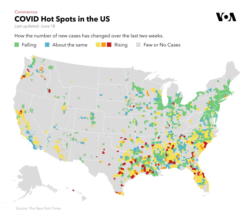It's been a frequent Trump administration talking point on the recent spike in COVID-19 infections: Don't worry, only a small sliver of U.S. counties is at greater risk.
In offering this reassurance, Vice President Mike Pence and Health and Human Services Secretary Alex Azar have said that only 3% or 4% of counties in the country are seeing a surge in cases. Focus on the "encouraging signs," Pence told senators last week.
But they and other administration officials are skirting a key fact: More than 20% of Americans live in those relatively few counties.
The White House has repeatedly cited the low county tally, and Pence reaffirmed the point in a televised interview Sunday. He argued that states, not the federal government, should take the lead with reopening guidelines because virus outbreaks are happening in about "4% of all the counties in this country."
Azar asserted Friday only 3% of counties represent "hot spots" that are "very concerning."
The emphasis on a percentage of counties makes for a misleading portrayal of the virus threat.
The White House provided The Associated Press with the full list of U.S. counties that reported increases in COVID-19 cases as of Friday. It showed 137 of the 3,142 counties in the U.S. that were under a higher alert — indeed, about 4% at the time.
But measured by population, those counties represent a vastly higher share — over 1 in 5 people in the U.S.
Altogether there are 68.3 million people living in those 137 counties, while there is a total U.S. population of 322.9 million. That means 21.1% of U.S. residents actually live in a virus "hot spot."
In recent weeks, the U.S. has entered a dangerous new phase of the coronavirus with big Sun Belt states showing thousands of new cases a day. Texas and Florida reversed course on parts of their reopening and clamped down on bars last week as the daily number of confirmed infections in the U.S. surged to all-time highs.
Speaking about the coronavirus threat Friday, White House coordinator Dr. Deborah Birx explained that counties large and small are being tracked by the White House task force, and that anyone living in a virus hot spot should take the necessary precautions, including social distancing and wearing a mask.
Citing increases particularly in the under-40 age group, Birx stressed that much more testing is needed because that's the age group most likely to be infected without showing symptoms and to be "spreading the virus unbeknownst to them."
The population figures, both county level and national, come from the Census Bureau's American Community Survey five-year estimates for 2018, the latest available.










